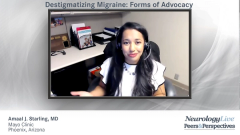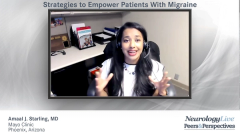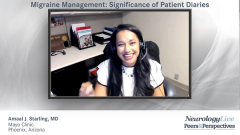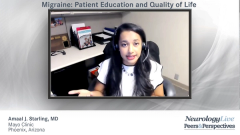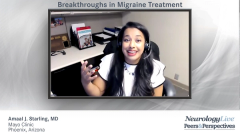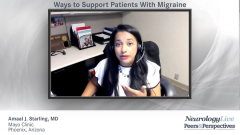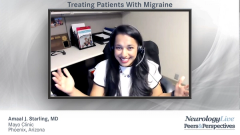
Treating Patients With Migraine
What physicians in the community need to know about treating patients with migraine in community settings, and resources that can help locate certified headache specialists or other migraine specialists for referral.
Episodes in this series

Jill Dehlin, RN: What is the gold standard for a headache specialist? What kind of certification is there?
Amaal J. Starling, MD: That’s a great question. A headache specialist, right now, is defined by having completed a UCNS [United Council for Neurologic Subspecialties] board certification. However, it is also loosely defined as someone who has an interest in treating people with headache diseases and migraine. That can be someone who is a primary care provider, a neurologist, and could also be someone who has the UCNS headache medicine board certification. The majority of people being treated for migraine will be treated at the level of their primary care provider because there are so many people with migraine, and the first person they’re going to present to is their primary care provider. We, as headache specialists, need to educate our primary care providers on the appropriate care for people with migraine because they really are our frontline providers. Emergency department physicians are our frontline providers as well.
Jill Dehlin, RN: Given that there are estimated to be over 40 million individuals with migraine disease and so few headache specialists, at what point does a primary care provider know it’s time to refer a patient to a specialist?
Amaal J. Starling, MD: That’s a really good question. I want to take a step back. For any physician or health care provider, when you have a patient with migraine in front of you, one of the most impactful things you can say to that individual is, “Look, I am never going to give up on you.” That may mean you know when you have reached the end of your expertise and when you are going to refer them to the next level of expertise. But that still means you haven’t given up on that individual. I think that’s, first and foremost, what’s important for that patient to know, that you’re with them until they are feeling better and are more functional.
It depends on how comfortable that primary care provider is with a variety of the treatment options available. There are some primary care providers who are very adept at managing relatively complicated cases of migraine disease. When I am teaching internal medicine residents, and when I am giving lectures at primary care conferences, what I’ll typically recommend for individuals is knowing how to identify migraine.
I’ll usually teach people ID Migraine screening. You look for at least 2 out of 3 things. You look for someone who has sensitivity to light, an inability to function, or nausea. If they have any type of head discomfort with 2 out of 3 of those, it’s more than likely going to be migraine. Usually, I tell primary care providers that if someone comes to you complaining of head pain, if it’s significant enough to talk about with their health care provider, it’s more than likely going to be migraine. Tension-type headache is mild to moderate pain that usually people will, on their own, treat with an over-the-counter medication.
So, identify and diagnose migraine, try at least 2 as-needed treatment options, and then try at least 1 to 2 preventive treatment options. If there is anything that’s concerning or red flags when you’re going through that process of diagnosis or trying those 1 to 2 acute or preventive treatment options, it is OK to refer to a general neurologist. Oftentimes that general neurologist will take the baton to that next level, and then if the general neurologist reaches their level of expertise, they may end up referring to a headache specialist.
As we talked about, there are 40 million people with migraine in the US, and there are about 700 board certified headache specialists. The ratio is awful, which is why our waitlists are very long. So it’s important for us, as headache specialists, to also train our general neurologists and primary care providers to become more adept at the identification, diagnosis, and initial standard-of-care treatment options for migraine.
Jill Dehlin, RN: I would like to also suggest for physicians who are looking for referrals, they can go to the American Headache Society website. There’s a composed list of the UCNS-certified headache specialists. There’s also one on the National Headache Foundation website, headaches.org, that also lists health care providers who are specialists in headache. They may not be neurologists but are very good at treating headache. It’s called the Certificate of Added Qualification in Headache Medicine. These are resources that health care providers can check to see what might be available for their patients in their area.
Amaal J. Starling, MD: Jill, thank you for bringing up all those resources. The American Headache Society also has a program right now called First Contact—Headache in Primary Care, which is specifically designed to provide free education for primary care providers to become more adept at identifying, diagnosing, and treating migraine and other headache diseases. It’s on the website for the American Headache Society, americanheadachesociety.org. It’s a great, freely available resource for primary care providers.
Jill Dehlin, RN: It’s exciting that the American Headache Society, and the National Headache Foundation, and others are exploring ways in which they can help primary care physicians and other health care providers become better, more adept at treating and diagnosing people with migraine disease.
Amaal J. Starling, MD: For sure. They’re the first-line providers, so it is so important.
Jill Dehlin, RN: Finally, what take-home messages do you have for a community physician treating migraine, and how can they educate themselves?
Amaal J. Starling, MD: My take-home message is that migraine is a very common, genetic neurologic disease that we can treat. People with migraine are just like you and me; they want to get better, and they want to be productive. For many, we have the tools to get them there. We, as physicians, must be aggressive and proactive in the diagnosis and treatment of migraine. Know your biases, and know that based on studies, we are most likely underdiagnosing migraine. We are most likely undertreating migraine, especially in Black, indigenous, and other people of color. Make an adjustment in your approach to the treatment of migraine management, so that we can address these unmet needs in health care.
Jill Dehlin, RN: Thank you for watching this NeurologyLive® Peers & Perspectives®. If you enjoyed the content, please subscribe to our e-newsletters to receive upcoming programs and other great content right in your inbox.
Transcript Edited for Clarity
Newsletter
Keep your finger on the pulse of neurology—subscribe to NeurologyLive for expert interviews, new data, and breakthrough treatment updates.

